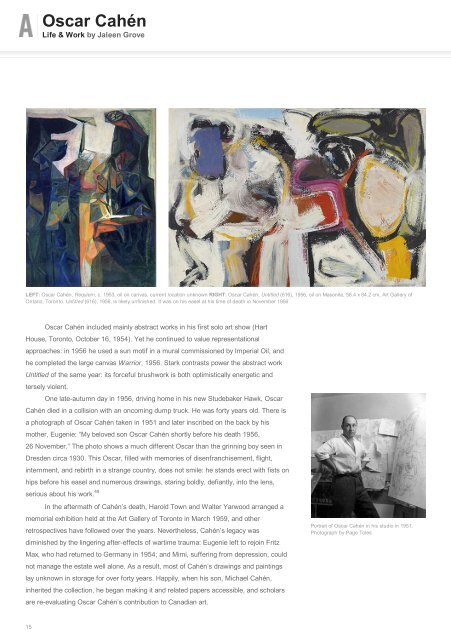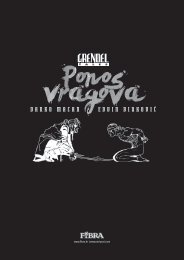Oscar Cahén
Art-Canada-Institute_Oscar-Cah%C3%A9n
Art-Canada-Institute_Oscar-Cah%C3%A9n
You also want an ePaper? Increase the reach of your titles
YUMPU automatically turns print PDFs into web optimized ePapers that Google loves.
<strong>Oscar</strong> <strong>Cahén</strong><br />
Life & Work by Jaleen Grove<br />
LEFT: <strong>Oscar</strong> <strong>Cahén</strong>, Requiem, c. 1953, oil on canvas, current location unknown RIGHT: <strong>Oscar</strong> <strong>Cahén</strong>, Untitled (616), 1956, oil on Masonite, 58.4 x 84.2 cm, Art Gallery of<br />
Ontario, Toronto. Untitled (616), 1956, is likely unfinished. It was on his easel at his time of death in November 1956<br />
<strong>Oscar</strong> <strong>Cahén</strong> included mainly abstract works in his first solo art show (Hart<br />
House, Toronto, October 16, 1954). Yet he continued to value representational<br />
approaches: in 1956 he used a sun motif in a mural commissioned by Imperial Oil, and<br />
he completed the large canvas Warrior, 1956. Stark contrasts power the abstract work<br />
Untitled of the same year: its forceful brushwork is both optimistically energetic and<br />
tersely violent.<br />
One late-autumn day in 1956, driving home in his new Studebaker Hawk, <strong>Oscar</strong><br />
<strong>Cahén</strong> died in a collision with an oncoming dump truck. He was forty years old. There is<br />
a photograph of <strong>Oscar</strong> <strong>Cahén</strong> taken in 1951 and later inscribed on the back by his<br />
mother, Eugenie: “My beloved son <strong>Oscar</strong> <strong>Cahén</strong> shortly before his death 1956,<br />
26 November.” The photo shows a much different <strong>Oscar</strong> than the grinning boy seen in<br />
Dresden circa 1930. This <strong>Oscar</strong>, filled with memories of disenfranchisement, flight,<br />
internment, and rebirth in a strange country, does not smile: he stands erect with fists on<br />
hips before his easel and numerous drawings, staring boldly, defiantly, into the lens,<br />
serious about his work.<br />
49<br />
In the aftermath of <strong>Cahén</strong>’s death, Harold Town and Walter Yarwood arranged a<br />
memorial exhibition held at the Art Gallery of Toronto in March 1959, and other<br />
retrospectives have followed over the years. Nevertheless, <strong>Cahén</strong>’s legacy was<br />
diminished by the lingering after-effects of wartime trauma: Eugenie left to rejoin Fritz<br />
Max, who had returned to Germany in 1954; and Mimi, suffering from depression, could<br />
not manage the estate well alone. As a result, most of <strong>Cahén</strong>’s drawings and paintings<br />
lay unknown in storage for over forty years. Happily, when his son, Michael <strong>Cahén</strong>,<br />
inherited the collection, he began making it and related papers accessible, and scholars<br />
are re-evaluating <strong>Oscar</strong> <strong>Cahén</strong>’s contribution to Canadian art.<br />
Portrait of <strong>Oscar</strong> <strong>Cahén</strong> in his studio in 1951.<br />
Photograph by Page Toles<br />
15



